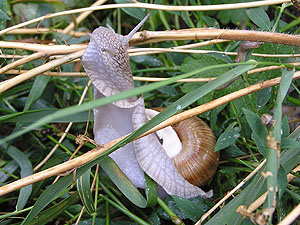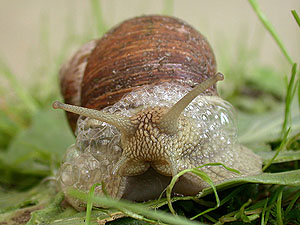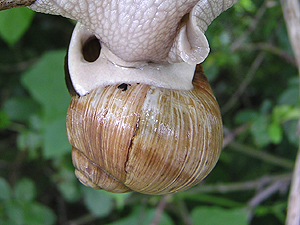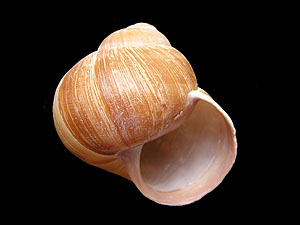| Diese Seite auf Deutsch! |
|
Body Parts and Organs |
|
Morphology In biology the subject dealing with the construction and function of creature's body parts is referred to as morphology. In general, like on this page, morphology can be divided into external morphology (the external appearance) and internal morphology (the construction of organs and organ systems). While the external appearance of an animal can be seen by observing, the snail must be killed and dissected to see the internal morphology, which is why organ function is hard to observe in a living animal. |
Observing a living snail crawling its way, it is easy to see the difference between the soft, flexible living body covered in mucus and the hard, apparently lifeless shell. Because a Roman snail is noticeably larger than most other terrestrial snails, it is not hard to observe parts of the living body and how they function.
 The arduous progress of a Roman snail on a way through the undergrowth reveals the underside of the foot sole. [RN] |
![]() Body parts and organs of a Roman snail.
Body parts and organs of a Roman snail.
Snails are as well known for their slimy appearance as for their proverbial slow movement. The entire visible body of the Roman snail is covered by a mucus layer secreted by numerous glands distributed over the body surface.
There are different kinds of snail slime: Snail slime can be highly viscous, but also almost watery. It can be rubbed between the fingers yet is difficult to wash off, since it does not dissolve in water; rather, it absorbs it. Snail slime consists of so-called mucoproteins, proteins that swell in water and bind it. Thanks to this water-binding capacity, land snails, although they have evolved on land for millions of years, are still effectively surrounded by a thin "coat" of water. This protection against evaporation is vital for their survival.
![]() Terrestrial Snails: Humidity.
Terrestrial Snails: Humidity.
 Snails can foam to protect themselves against harmful agents or against other disturbances. Picture: Ingrid Mittelstaedt. |
Against small attackers, however, such as e.g. ants, there is scarcely any mechanical defence, since the Roman snail cannot seal its large shell aperture effectively. To deter such small enemies, the snail produces large amounts of thin mucus, which it foams by expelling air from the mantle cavity in short bursts. Ants are thus prevented from injuring the snail. The snail can also produce a hissing sound, which may startle attackers. In producing deterrent sounds, the Roman snail is even surpassed by its relative, the green snail (Cantareus apertus), whose name refers to the conspicuous hissing emitted when threatened.
Such a defensive reaction occurs not only when the snail is attacked, but also when it comes into contact with painful substances or anything else highly unpleasant. The foamy mucus evidently also serves to wash off such substances.
![]() Snails: Mucus.
Snails: Mucus.
Most of the sensory organs are located on the head; since the head always points in the direction of movement, it may be described as the snail's orientation centre. While moving, a Roman snail constantly explores with its four tentacles, arranged in two pairs along the midline of the head. The smaller, lower pair is directed towards the substrate, while the two longer tentacles scan the surroundings. Their primary purpose is to provide the eyes, located at the tips, with a wide field of view. The eyes of the Roman snail are among the most advanced photoreceptors in molluscs: lens eyes, as in vertebrates. Based on the limited range of receptor cell types, however, the snail likely perceives at best a black-and-white image, and in any case can distinguish light and dark.
 A Roman snail's eye stalk. Picture: Martina Eleveld. |
When the snail feeds, one can see the mouth behind the lips - the beginning of the digestive tract. As with the outlets of several other organ systems, the anus opens within the mantle fold at the shell aperture, close to the breathing pore. Usually on the right side of the body, at the end of a longitudinal groove, lies the opening of the genital apparatus, as is clearly visible during mating.
![]() Snails:
Head.
Snails:
Head.
 The underside of a crawling Roman snail. The dark transversal bands are waves of the foot sole, by which the snail moves. In the left part of the picture the snail's characteristic slime trace can be seen. [RN] |
Unlike the conspicuous exploratory movements of head and tentacles, the actual locomotion proceeds imperceptibly, at a snail's pace. Viewed from below through glass, one can observe transverse waves moving from back to front: a posterior section of the sole lifts from the substrate and is set down slightly further forward; after the wave has passed along the entire sole, the snail has advanced a short distance.
As seen clearly in the image, the transverse waves do not extend across the entire width of the sole: the lateral margins remain in contact with the ground, allowing the snail to adapt perfectly to the substrate, avoid injury, and even cross thorns and other sharp plant parts. The suction effect of the sole's margin creates negative pressure, which one can feel when attempting to detach a snail from a smooth surface.
 Movie of a crawling snail (Cornu aspersum). [RN] MP4-File, ca. 1.5 MB. |
![]() Snails:
Foot.
Snails:
Foot.
A portion of a Roman snail's body never leaves the shell in life. To examine these parts, the shell must be removed from a dead animal. One then sees a sack-like body region on the back, coiled like the shell and fitting its interior. This region contains various internal organs, such as the large hepatopancreas, which performs functions analogous to the liver. This region is called the visceral sac. Externally it is covered by a resistant tissue that forms a thick fold at the shell aperture: the mantle (pallium). Together, mantle and visceral sac form an inseparable complex, the visceropallium.
The mantle fold at the shell aperture is a special adaptation of land snails not found in aquatic snails.
 A living Roman snail's shell mouth. From this point of view the mantle and the respiratory hole are easily recognisable. [RN] |
 Most Roman snails' shells are dextral – the shell mouth is right of the shell's longitudinal axis. [RN] |
![]() Snails:
Mantle and Shell.
Snails:
Mantle and Shell.
The mantle does not only protect the visceral sac and mantle cavity from evaporation; it is also responsible for shell formation:
Newly hatched juveniles already possess a small, glassy shell, which grows continuously until sexual maturity at about three years, increasing both in size and wall thickness. Gland cells on the mantle surface secrete a calcium-rich substance that crystallises within the shell and at the aperture. Special gland cells in the outermost layer at the aperture apply a thin organic layer to the primarily calcareous shell material. This layer protects the shell from environmental influences and imparts colour to the originally white shell.
During their evolutionary history, the snail's visceral sac and mantle have coiled asymmetrically on one side of the body. Consequently, the shell is likewise asymmetrically coiled: its shell tip (apex) lies to one side; in Roman snails this is usually the right. On the other side, there is a hole between the shell whorls called the shell navel (umbilicus).
Apart from these dextral shells, there are rare sinistral mutants, called "snail kings" because of their extreme rarity (roughly one in tens of thousands).
![]() Snails:
Shell.
Snails:
Shell.